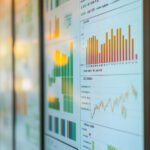Zennemis – Imagine a future where energy management isn’t just about making power, but also about using data smartly. In the world of data analytics in utilities, a big change is happening. Companies are using advanced data analytics to improve how they work, make customers happier, and meet green goals.
The market for big data analytics in energy is expected to jump from USD 8.37 billion in 2023 to USD 14.28 billion by 2028. This growth is mainly because North America wants new ways to manage utilities.
Thanks to IoT devices and advanced tools, we can now track how much energy we use and guess what we’ll need next. This change lets us fix problems before they start, cut down on wasted time, and quickly solve grid issues. By using energy sector analytics, utilities can work better and help move to renewable energy sources. Let’s dive into how data analytics is changing utilities and making smarter solutions for a green future.
Introduction to Data Analytics in Utilities
Data analytics is changing the game for utilities. It turns huge amounts of data into data-driven insights for utilities. This shift is key as the industry moves to smart grids, smart meters, and IoT solutions. Our team has over 25 years of experience in data analytics, now focusing on smart meter diagnostics for quick insights.
Using an event storage and analytics platform (ESAP), utilities get actionable insights. Our advanced forecasting uses machine learning to predict energy use patterns. Data and analytics are key to making decisions and improving customer experiences.
With data-driven insights for utilities, we spot unusual usage patterns. These could mean fraud or equipment problems. Data analytics also helps with reliability and managing risks. It helps prevent power outages, predict when to replace equipment, and improve performance.
Utility data analysis offers more than just better operations. It reveals hidden trends and checks performance. This leads to smarter business moves, more profits, and happier customers. Yet, there are challenges like making data easy to access and keeping it reliable. But, companies that overcome these challenges can lead in a changing market.
The Role of Big Data in the Energy Sector
Big data has changed the energy sector, bringing new ideas and making things run better. It helps us manage how we produce and use energy. By using real-time data, we can predict energy needs and plan better.
More companies are using energy sector analytics, which will grow the market. It’s expected to jump from USD 2 billion in 2020 to USD 4.3 billion by 2025. This change is driven by more connected devices, which will increase from 41.8 billion to 55.7 billion by 2025.
Using big data is key to being sustainable and following the rules. For example, a UK water company saved £7 million and avoided service problems by using analytics. This shows how data can make a big difference.
Data analytics is crucial for making utilities better. It helps them get ready for more electricity use by 2050. With 74% of utilities using or checking out AI, advanced analytics is key to better service and happy customers.
Looking ahead, managing data well and using data management platforms is important. Setting standards for data collection makes analysis easier and faster. This leads to smarter decisions that help us and our customers. Being ready and flexible will help us do better and be more sustainable in the energy sector.
Grid Optimization Through Data Analytics
Using data analytics changes how utilities manage their grids. Smart grid analytics help make our energy systems better. They make sure our energy systems can handle today’s needs.
Real-time Monitoring and Analysis
Real-time monitoring and analysis are key to a better grid. Smart grid analytics software gives us important insights on how assets perform. This lets us quickly fix problems like outages or capacity issues.
By looking at data from smart meters and SCADA systems, we stay flexible and manage loads well. Utility data visualization tools help us understand complex data. This makes it easier to make smart decisions.
Identifying Patterns and Predicting Failures
Looking at past data helps us see when equipment might fail. Smart grid analytics lets us fix problems before they get worse. This makes our equipment last longer and keeps the grid stable.
These analytics tools help us see peak loads and how people use energy. This helps us plan for things like electric cars. The benefits include saving money and running things more efficiently.
| Benefits of Smart Grid Analytics | Description |
|---|---|
| Improved Reliability | Enhanced detection and resolution of outages through real-time monitoring. |
| Cost Savings | Avoiding expenses related to excess inertia via smart inertia management. |
| Asset Management | Reduction of downtime and optimized life cycles through detailed asset performance insights. |
| Proactive Maintenance | Predicting equipment failures allows us to intervene before outages occur. |
| Renewable Integration | Maintaining power supply via analytics-driven deployment of distributed energy resources. |
Smart grid analytics and utility data visualization tools help us build a better energy grid. They benefit both utilities and consumers.
Predictive Maintenance for Utilities
Predictive maintenance for utilities is changing how we work. It uses advanced tech like Artificial Intelligence (AI) and the Internet of Things (IoT). This lets us fix problems before they happen, making our services better.
This new way of working means we can stop equipment failures before they start. It makes us more ready to respond and improves how well we work.
Benefits of Proactive Maintenance Strategies
Being proactive has many perks. It cuts down on downtime, lowers costs, and makes better use of resources. By predicting equipment problems, we can fix them early.
This means less trouble for our customers and a more reliable service. It ensures we always have enough energy for everyone.
Utilizing Sensor Data for Equipment Integrity
IoT devices let us keep an eye on equipment in real-time. They alert us to any issues right away. This info helps us make quick fixes to keep our equipment running longer.
By using AI and IoT together, we keep getting better at predicting maintenance needs. This keeps our equipment running smoothly and prevents sudden failures.
FAQ
What is data analytics in utilities?
Data analytics in utilities uses big data and advanced software to improve performance. It also aims to increase customer satisfaction and manage resources better in energy companies.
How can utilities leverage data analytics for operational efficiency?
Utilities use data analytics to study how much energy people use and when. This helps them predict demand and keep an eye on how things are running. This leads to better use of resources and more reliable services.
What are the benefits of predictive maintenance for utilities?
Predictive maintenance helps utilities know when equipment might break down. This means less downtime, lower costs, and better use of resources. It ensures customers always get the energy they need.
Why is big data important in the energy sector?
Big data is key in the energy sector. It helps make operations more efficient, cuts costs, and improves decision-making. It does this by analyzing a lot of data on energy production and use.
What role do IoT devices play in utility data analysis?
IoT devices send real-time data that helps improve utility data analysis. This data shows how customers use energy, how systems work, and helps make the grid better. It also makes services more reliable.
How does data analytics contribute to compliance with regulatory standards?
Data analytics helps utilities follow rules by monitoring and reporting on energy use better. This supports efforts to be more sustainable.
What is smart grid analytics?
Smart grid analytics uses data from smart meters and advanced grid tech. It makes energy distribution systems more reliable and efficient. This helps utilities adjust to changing conditions.
How can utilities visualize their data?
Utilities use data visualization tools to make complex data easy to understand. This lets people make better decisions with insights from utility data analysis.




